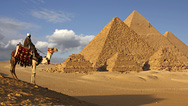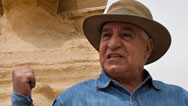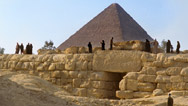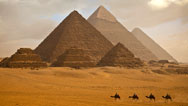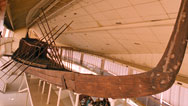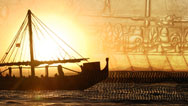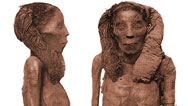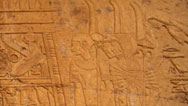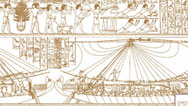
Riddles of the Sphinx
A marvel of ancient Egyptian engineering is threatened. Can it be saved? Airing December 19, 2012 at 9 pm on PBS Aired December 19, 2012 on PBS
- Originally aired 01.19.10
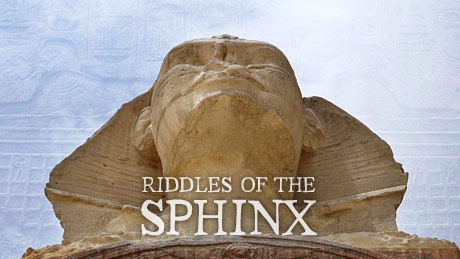
Program Description
Transcript
Riddles of the Sphinx
PBS Airdate: January 19, 2010
NARRATOR: Nothing represents the mysteries of ancient Egypt more than the Great Sphinx. How did the Egyptians build this crouching lion, human-headed creature?
ZAHI HAWASS (Supreme Council of Antiquities): This is the largest statue ever built in ancient Egypt.
NARRATOR: Who built it and why?
MARK LEHNER (Ancient Egypt Research Associates): When it was in its heyday, it was a very brightly painted image, painted in comic-book colors.
NARRATOR: The riddles of the Sphinx have puzzled all who have laid eyes on it, from emperors to presidents.
Now, solving those riddles has taken on a new urgency, for after more than 4,000 years with only pyramids as neighbors, today, the Sphinx stares out at a fast-food restaurant. Traffic, tourism and construction are trembling it apart.
ZAHI HAWASS: The Sphinx is almost in downtown Cairo.
NARRATOR: It's a full frontal urban assault. Before it's too late, two teams of scientists and builders are tackling the age-old riddles of the Sphinx. They're immersing themselves in the world of ancient Egypt, a world of pharaohs and pyramids, animal gods and mummies, sun worship and human sacrifice.
Will the eternal sands of Egypt finally give up the secrets of this human-headed lion? Up next on NOVA: Riddles of the Sphinx.
Giant paws, longer than a city bus stretch out before it. A whipping tail, wraps around its back. And its enormous body, about the weight of fifty 747 jumbo jets, is on haunches, poised to pounce.
But this lion has a human head as big as a house, for this is the Great Sphinx.
At nearly 240 feet long—almost the length of a football field—and almost 70 feet tall—the height of the White House—the Sphinx is the largest statue in all of Egypt, a land renowned for its oversized monuments.
It is here at Giza, home of the Sphinx and the Great Pyramids, where building big really booms. Around 2500 B.C., more than 4,000 years ago, the Giza Plateau is a desolate landscape. A visionary Pharaoh named Khufu constructs the Great Pyramid. He's followed by his son, and then his son's son, who build two more pyramids.
Designed as giant tombs to insure the kings' safe passage to the afterlife, the pyramids and their surrounding temples transform an area of the Giza Plateau into a vast city of the dead. Pharaoh Khufu's pyramid is the most famous gravestone on Earth.
MARK LEHNER: Khufu's architect probably stood here and looked out over the panorama behind me and maybe foresaw three generations of building here, because of the excellent conditions for carving giant statues and for building pyramids and tombs.
NARRATOR: Khufu and his sons launch a golden age of Egypt, known as the Old Kingdom.
But while the classic pyramid can be traced back to earlier forms, like the stepped pyramid of Saqqara, the Great Sphinx appears out of nowhere, unprecedented in size and form. And while inscriptions inside the pyramids reveal who built them, there are no such clues about the origins of the Sphinx.
What is this crouching lion, human-headed beast? How did the Egyptians build this wonder of the ancient world? Whose face is this staring out across the millennia?
Now two teams tackle these age-old mysteries of the Sphinx.
One team of scientists investigates the geology, history and archaeology of ancient Egypt.
ZAHI HAWASS: Many people who try to look at the Sphinx, they look at it by itself. But you have to look at all the architecture, archaeology, art, inscriptions. You have to look at all of this to explain the function of the Sphinx.
NARRATOR: Another team of stone-carvers will build scaled-down replicas of the Sphinx and its missing nose, to shed light on how the ancients carved this wonder of the world.
RICK BROWN (Handshouse Studio): It's near mind-boggling; in all Egypt, most of the stone was carved with just pounding for thousands and thousands of hours.
NARRATOR: The race is on to unlock the riddles of the Sphinx.
There have been thousands of sphinxes throughout history, but this sphinx, the Great Sphinx, is one of the very first, and is by far the largest ever built.
MARK LEHNER: This was an age of experimentation. The Sphinx is an experiment. It was something new, something highly unusual.
NARRATOR: So where did the idea of putting a human head on a lion's body come from?
Archaeologist Gunter Dreyer is searching the desert of Abydos, about 300 miles south of Giza and the pyramids. Dreyer is traveling back past Khufu and the Old Kingdom, to the very dawn of Egyptian civilization: 3000 B.C., 500 years before the Sphinx.
Like Giza, Abydos is also a city of the dead, but without pyramids. Here, Egypt's founding pharaohs are buried beneath the desert sands in a complex of mud-brick tombs.
Today, Dreyer is investigating one of those tombs.
GUeNTER DREYER (German Archaeological Institute): The tomb consists of three huge chambers underneath that mound over there; and in front of it, there are three rows of subsidiary burials; altogether, 35.
NARRATOR: The main chamber was plundered in ancient times and the royal body stolen, but inscriptions found inside reveal a name, Pharaoh Aha, the very first king of Egypt's First Dynasty.
As pharaoh, Aha wielded absolute power.
The Abydos excavation reveals evidence of human sacrifice: the skeletons of 35 healthy adults, most under the age of 20, all part of a mass burial.
GUeNTER DREYER: Even at that remote time, that is not a natural age of death, and so we may conclude they were killed to follow the king in his afterlife, to serve him there in eternity.
NARRATOR: The pharaoh and his worldly goods are buried at one end of the complex, followed by the 35 victims of human sacrifice, in smaller tombs, and in the last tomb are even more bones, but these are not human. For identification, they were compared with modern skeletons.
GUeNTER DREYER: We found a lot of animal bones, especially bones of lions. That was quite a surprise.
NARRATOR: Several lions died and were buried at the same time as the young adults, evidence that they, too, were sacrificed. But why were these lions entombed along with the pharaoh?
GUeNTER DREYER: The king identifies himself with the lion to show his power, to express his power.
NARRATOR: Dreyer's excavations reveal that Egypt's first Pharaohs wielded enormous power—enough to command the ritual slaughter of dozens of people. And the lion sacrifices provide the first clue to the meaning of the Sphinx's form: lions symbolize the power of the pharaoh.
But the Sphinx is more than just a lion, it's also part human. Ancient Egyptians depict their gods as part animal, part human, but usually those gods have animal heads and human bodies. The Sphinx is just the opposite.
MARK LEHNER: When you put the human head on the lion body, you have all the strength and power of the lion, and you have the human head which is a symbol of intelligence and control. And so, it is an image of power under control.
NARRATOR: But whose power and control?
MARK LEHNER: The human head is actually wearing a scarf called the nemes. It's a headdress, and only the pharaohs wore the nemes headdress.
NARRATOR: So the Sphinx is both a god and a pharaoh, and when it came to symbolizing the power of the pharaoh, the bigger, the better.
Over the next 500 years, the pharaohs' tombs got more and more massive—from underground burial chambers to simple aboveground tombs, and from stepped pyramids to the Great Pyramids of Giza. But while the form and size of royal tombs evolve slowly, the Great Sphinx has no precedent.
MARK LEHNER: It was the first time in the history of Egypt that they created sculpture at this scale.
NARRATOR: So how was the Sphinx created?
Looking at its paws, it appears to be built with thousands of blocks. Was it constructed like the pyramids, by stacking blocks of stone?
But a closer look reveals that its upper body and head are carved out of one huge rock. Does that mean it was carved like Mount Rushmore? Clues lie in the stone of the Sphinx and the rock around it.
Amazingly, nobody had ever investigated its stones in any detail, until Mark Lehner, 30 years ago. Today, he's one of the world's leading Egyptologists.
MARK LEHNER: When I first came to Egypt. The best maps that existed of the Sphinx were simply the outline.
NARRATOR: If you're investigating how the Sphinx was built, the existing drawings were about as useful as if you were trying to build a 50-story skyscraper using just a satellite snapshot of its roof. That's how little was known about the Sphinx.
To unlock its secrets, someone needed to take a much closer look.
MARK LEHNER: I spent five years here, mapping every stone to scale. This was my office. And I would take my breaks here and have a stale cheese sandwich and a cup of Nescafe(R).
NARRATOR: Lehner's mapping gave him an intimate knowledge of the Sphinx, its stone and the Giza Plateau.
To begin with, the Sphinx is made of limestone. Close inspection of the limestone reveals how it was formed.
MARK LEHNER: You see a pattern that looks kind of like a brain coral, or almost like a sponge. All the limestone at Giza, including the body of the Sphinx was once the floor of the sea; it was a seabed. So you have, frozen into the stone, various elements of seafloor life.
NARRATOR: Millions of years ago, the Giza Plateau was under water. Sea creatures and plants died, falling to the bottom. Over time, their remains were compressed to form limestone. But not all limestone is created equal.
Some limestone is formed from the soft sea bottom and some from hard coral reefs. Together they form a kind of layer cake of hard and soft limestone.
MARK LEHNER: The Sphinx is composed out of several different limestone layers. So it's as though you carved the Sphinx out of a layer cake. And there are gooey layers of soft frosting, and then there are intervening harder layers.
NARRATOR: The harder layers of rock have held up better than the softer layers. Today it looks a lot different from when it was first built. Its original smooth surface has been eaten away by over 4,000 years of wind, water and sand.
MARK LEHNER: Here on the right side of the Sphinx's chest, we can see how weathering has put the softer layers into deep recesses, while the harder layers protrude.
NARRATOR: To Lehner, this weathering pattern is another important clue to how the Sphinx was built. Recent restorations obscure this pattern, but photographs from the 1920s, clearly show it on both the body of the Sphinx and on the side of what is known as the "Sphinx ditch."
The pattern acts like a fingerprint, and when Lehner compares the Sphinx's body with the side of the Sphinx ditch, it's a perfect match.
MARK LEHNER: We are certain that these are the same layers of natural rock that form the south side of the Sphinx ditch.
NARRATOR: Lehner identifies more of that rock directly in front of the Sphinx's paws, in the ruins of a building known as the Sphinx temple. There, on the huge stone blocks that were once the walls of the Sphinx temple, he discovers those same familiar layers of hard and soft stone that he finds on the Sphinx.
MARK LEHNER: You can see the layers run continuously from one block to another through many of the blocks forming the temple walls. Here is one geological layer, then this yellow band is a softer geological layer.
NARRATOR: But what does the similarity of the rock in the Sphinx, ditch and temple tell Lehner about how the Sphinx was built?
MARK LEHNER: The Egyptians quarried a horseshoe-shaped ditch leaving a core that left a big block from which they carved the Sphinx itself. They moved the stone, sometimes in blocks of a hundred tons, down to the lower terrace for fabricating the walls of the Sphinx temple.
NARRATOR: So the starting point for the Sphinx must have been a huge rock sticking out of the surface of the Giza Plateau. Workers cut a trench around it, quarrying the stone out from the ditch in huge blocks. They hauled off those blocks to build the nearby Sphinx temple, then sculptors carved the giant rock remaining in the center into the shape of the Sphinx.
MARK LEHNER: The Sphinx was carved right out of the natural mother rock of the Giza Plateau.
NARRATOR: But knowing that it's carved right out of the earth is only half the mystery. How did they actually do it? Sculpting a human-headed lion out of 20,000 tons of limestone is no small matter.
RICHARD REDDING (University of Michigan): So, Fathi, we need to get two types of rock.
NARRATOR: To investigate the challenges faced by the ancient sculptors, archaeologist Richard Redding and Fathi Mohammed, a stonemason who has worked at Giza since he was a boy, team up to carve a mini-sphinx.
RICHARD REDDING: So let's see what we can find here.
NARRATOR: They search for limestone that's as hard as the layer in the Sphinx's head.
RICHARD REDDING: I think we've got it right here. What you can see is this one's nice and strong, like the head.
NARRATOR: They find just the right stone in a nearby quarry. It's extremely heavy and hard, maybe too hard.
FATHI MOHAMED (Sculptor): Mr. Richard?
RICHARD REDDING: Yes?
FATHI MOHAMED: All the equipment will be ruined. What will I work with in the future? The equipment will be ruined!
NARRATOR: Fathi is worried that the hard rock will ruin his tools.
FATHI MOHAMED: I see a problem. The tool is made of steel but the rock bent it! The rock is very hard. With what will I continue my work?
NARRATOR: If Fathi is having such a difficult time using modern steel tools, how did the ancient Egyptians carve the Sphinx with more primitive tools?
The answer will come half a world away.
MARK LEHNER: Hey, Rick, New England in the fall is a far cry from Egypt in the desert.
NARRATOR: Mark Lehner has come to consult with Rick Brown, a specialist in ancient tools.
Based on actual copper tools found at Giza and tomb scenes depicting stonecutters at work, Brown gathers everything an ancient Egyptian would have had to carve the Great Sphinx.
MARK LEHNER: Rick and I got together and looked at all the evidence we have from the tomb scenes, from actual tools that we found. And based on all this evidence, Rick has put together the rudiments of the toolkit that the Sphinx builders would have used.
RICK BROWN: So we have copper chisels, two-handed pounder, and there's the hammer.
NARRATOR: To really understand the challenge of using these tools for carving, Lehner and Brown begin by making them, starting with a copper chisel.
MARK LEHNER: Is that a good...
RICK BROWN: Even a little bit more. Right now, we just need to get some good heat.
NARRATOR: Working long before the invention of harder bronze or iron, the Sphinx sculptors had to make do with softer copper.
RICK BROWN: This is what they would have done in Egypt. What I want to do is take this blank of copper, heat it, and we'll fashion it into a chisel.
NARRATOR: The pure copper starts out a metal gray, and, as it heats, it turns red.
MARK LEHNER: So you want this copper red-hot.
RICK BROWN: Yeah, when I get color in the copper, we're ready.
NARRATOR: The heat softens the copper into a more pliable material that can be pounded into shape.
RICK BROWN: You know, this process is so basic. What they were doing was, they were using a hard material to fashion and shape a softer material.
NARRATOR: But as the soft copper cools, it hardens again.
RICK BROWN: I want to go back to the fire, because I could actually break the metal.
NARRATOR: Already, these ancient tools reveal there's more to making the Sphinx than just carving.
MARK LEHNER: Charcoal was a crucial ingredient of making these monuments at Giza. They must have been trucking wood in and feeding these fires all day long, all year round. Just to make the tools to make the monument.
NARRATOR: The heating-pounding cycle is repeated over and over, until the shape is just right.
RICK BROWN: I want it to be straight along the axis, just like this, because if it's turning a little bit, that means it's not going to last as long.
MARK LEHNER: They must have amassed more copper for building the Great Pyramid and the Sphinx than just about anyplace in the world in the third millennium, B.C. I mean, it just must have been a huge cost in copper.
NARRATOR: But the copper chisel was the high-tech finishing tool of the Old Kingdom. The real grunt work was achieved with something much more basic, stone hammers.
RICK BROWN: Mark, if you look at this photograph from the tomb of Ti, there is a stone carver using a tool like this. And this is what I've discovered: you have to look closely at these drawings, because they give a lot of information.
NARRATOR: Based on this 4,000-year-old tomb painting, Brown and Lehner make their own hammers today.
RICK BROWN: I want to use a harder stone against a softer stone.
MARK LEHNER: So you're using a stone to make a stone tool.
Whole lot of pounding going on.
NARRATOR: The grooves and lashing transform a simple stone into an effective hammer.
MARK LEHNER: It's not easy is it? But, like I say, they probably did it as quickly as tying a shoe.
The thing about this is—I think the critical thing—is it gives a lot more action.
RICK BROWN: He can work like that for many, many hours and not wear himself out.
NARRATOR: Now Lehner and Brown will put the tools to the test. They're going to attempt to carve the feature of the Sphinx that's most conspicuously absent: the nose.
There are stories that it was shot off by Napoleon's soldiers using it for target practice, but they turn out to be false.
MARK LEHNER: About 300 years before Napoleon, an Arab historian already mentions that the nose is gone. I think there is good evidence that it was snapped off intentionally. There's a deep wedge down the bridge and there's another groove down the Sphinx's left nostril. I think somebody might have pounded in these metal wedges and snapped it off to the south.
NARRATOR: While the original nose is lost forever, today Lehner and Brown, with just stone hammers and copper chisels will carve a new one.
MARK LEHNER: Let's go to work.
NARRATOR: Out of this six-foot chunk of hard limestone, they will attempt to carve a nose about one-third the size of the original.
MARK LEHNER: We're going to make this nose starting with tools like this? Was that my idea?
RICK BROWN: Oh yes!
NARRATOR: They dive in and quickly discover that hard stone is much more effective than the soft copper in these early stages.
RICK BROWN: I think that's the evidence that the pounder, even though it seems primitive, is actually quite effective.
NARRATOR: But even with reinforcements and after hours of pounding, they've barely made a dent. Will Lehner and Brown really be able to carve a nose with these ancient tools?
Zahi Hawass, Secretary General of Egypt's Supreme Council of Antiquities, is the official guardian of the Sphinx. He has searched this colossal cat from head to toe for clues to how it was built.
He knows, from the geology, that it was carved right out of the earth. So why does the bottom appear to be built out of stone blocks like the Pyramids?
Hawass investigates the size and style of the blocks for answers.
ZAHI HAWASS: If you look at the two paws of the Sphinx, this is a typical small stone that the Romans, in 30 B.C., came, and they did add this to the Sphinx.
NARRATOR: Just between the Sphinx's paws, Zahi Hawass finds blocks from four different periods.
ZAHI HAWASS: This is 30 B.C., 1550 B.C., and this is 2600 B.C.
NARRATOR: Hawass concludes that Egyptians, Greeks and Romans have been covering the Sphinx in blocks for thousands of years; but why?
The answer can be found in a deadly hidden force attacking the limestone of the body of the Sphinx and the surrounding ditch.
MARK LEHNER: All of this was once the floor of a sea. It was a seabed, 50 million years ago, so it's naturally full of salt.
NARRATOR: When groundwater rises, it seeps through the rock, drawing the salt to the surface, where it crystallizes and expands. The results are disastrous for the Sphinx.
MARK LEHNER: I hate to do this, but it's happening naturally all the time. On this wall next to the Sphinx, the flakes fall and crumble. This is what was happening to the Sphinx body. It's this process that results in, literally, Sphinx dust.
NARRATOR: Amazingly, from the day it was built, the body of the Sphinx has been turning to dust. The blocks put there by Egyptians, Greeks and Romans were to protect and conceal its deteriorating body, especially the more vulnerable parts carved from soft limestone.
But while the soft stone is bad news for the Sphinx, it's good news for sculptor Fathi, because it's much easier to work with as he carves his mini-sphinx.
FATHI MOHAMED: Now I'm working on the foot of the back leg. I'm sculpting the paw and the thigh.
NARRATOR: He makes quick progress because the stone is so soft, but now comes the hard part. Fathi reluctantly returns to the head, which, like the original Sphinx, is made of much harder limestone. Striking this harder rock, his chisel is far less effective, and progress slows dramatically, even with the advantage of his modern steel tools.
So how are Lehner and Brown progressing, back in New England, with their ancient copper tools?
After days of work, their copper chisels and stone pounders are barely making a dent. At this pace, it's unlikely they are going to carve a nose out of this rock any time soon, unless Brown and his team resort to taking some shortcuts.
RICK BROWN: Well, I guess you caught us. We worked on the stone for a long time using the Egyptian tools and then decided we'd move to the modern tools; it's a lot faster.
NARRATOR: Granted, the power tools are a lot faster than the ancient tools. But surprisingly, the basic carving process hasn't changed much since ancient times.
RICK BROWN: What the Egyptians would do is they would make these channels—parallel channels—then you come back with a flat chisel and blast out all that material in between.
NARRATOR: But while Brown's pneumatic chisel has a carbide tip, hammering 2,000 hits per minute, the copper chisel the ancient Egyptians would have used lasts only a few dozen strikes.
RICK BROWN: You can see, after I've only gone the equivalent of, maybe, 10 centimeters, my tool's already almost useless. Each time the tool gets dull, you've got to come back and reheat. When we reheat, it softens the metal and then we can reshape it.
NARRATOR: Brown is wearing down tools at an extraordinary rate. For efficiency, he moves his forge closer to the carving.
RICK BROWN: We brought our forge closer to the stone, because we're blowing through the copper chisels so fast. It gives us the opportunity to use them, dull them, sharpen them, and go right back to work, which is probably like they did in Egyptian times.
NARRATOR: Brown is discovering it's taking a lot of time and a great number of copper tools, and his stone shows little evidence of progress.
It's hard to imagine this hunk of rock will ever be a finished nose, even one a third the size of what was originally on the Sphinx. It's even harder to imagine carving the Great Sphinx as big as a football field.
Clearly only a pharaoh could pull this off. The question is, "Which one?"
The location of the Sphinx undoubtedly links it to the pyramids.
Whoever built the pyramids, likely built the Sphinx. The problem is the Sphinx appears to sit right between two pyramids, built by two different Pharaohs.
The first, and largest, pyramid was built by Pharaoh Khufu, who reigned around 2500 B.C.
His son Khafre built the second, slightly smaller pyramid.
Rainer Stadelmann, a leading Egyptologist, believes the head of the Sphinx represents the pharaoh who built it. So Stadelmann compares the face of the Sphinx to the face of the pharaohs, in hopes of revealing its true identity.
He turns to the only undisputed portrait of Khufu ever found, a small ivory statuette.
RAINER STADELMANN (German Archaeological Institute): This piece is something extraordinary. And I am so excited that you can open it.
NARRATOR: It has not been removed from its glass home in the Cairo Museum for 30 years.
RAINER STADELMANN: It is something. I would not have believed that we are allowed to do this. And this statue is a real masterpiece.
Everything is very finely sculpted, so detailed, that one can compare the statue with the enormous Sphinx. The face is, for me, the same face as the Sphinx, a square face, a little bit bitter mouth, uh, the eyes are protruding.
NARRATOR: But there's also a less subjective clue.
Unlike his son Khafre, builder of the second pyramid, Khufu does not have a beard.
RAINER STADELMANN: The statue does not wear a beard. So I am quite sure the Sphinx, which has no beard at all, is a picture of Khufu.
NARRATOR: But Mark Lehner finds evidence that the Sphinx originally had a beard.
And he believes the face of the Sphinx is the son, Khafre.
MARK LEHNER: An original beard would explain this very enigmatic bump on the Sphinx's chest. It starts right about here, and it's just right in position to support the long beard.
NARRATOR: The debate rages on: the father, Khufu, or his son, Khafre? The Sphinx's identity crisis cannot be resolved by facial features alone.
For Fathi, sculpting the mini-sphinx, a solution is needed.
With the body almost completed, Fathi returns to the harder stone for the head and must decide: beard or no beard?
FATHI MOHAMED: I think the Sphinx used to have a beard because all of the pharaonic statues in the form of the sphinx had beards, like those of Hatshepsut and those of Ramesses have beards, so the Sphinx must have had a similar beard.
NARRATOR: It's the crowning moment, as Fathi places the head on the body of his mini-sphinx. But the face is not that of Pharaoh Khufu or Khafre. It turns out, Fathi has ignored the advice of all the experts and followed in the tradition of the pharaohs: Fathi's sphinx bears a striking resemblance to Fathi.
For more than 4,000 years, this curious creature has captured the imagination of kings and emperors, poets and painters, and presidents.
Today the Sphinx is the face of Egypt and icon of its age-old mysteries, but what did it mean to the ancient Egyptians?
The Old Kingdom collapses, and the Giza plateau becomes an abandoned cemetery, the Sphinx and pyramids neglected. Nearly a thousand years pass, and the power of the pharaohs rises again, in a period called the New Kingdom, beginning about 1500 B.C.
But centuries of wind and water have eroded the Sphinx's fragile body and desert sands have swallowed the Sphinx up to its neck.
What happens next is written in hieroglyphs on a gigantic 15-ton granite stela, perched between its paws.
The inscription tells of a hero who rescues the Sphinx. A young prince clears away the sands, and the Sphinx rewards him by making him king.
His name is Thutmoses.
ZAHI HAWASS: Who the first restorer on Earth? I can say it is Thutmoses IV. He ordered his people to build these two huge mud-brick walls to protect the Sphinx from sand.
NARRATOR: Opposite the Sphinx's left haunch and above the Sphinx ditch are remnants of a mud-brick wall. Some of its bricks are stamped with the name of Thutmoses. Originally coated in plaster, the wall stood nearly 30 feet tall.
And to restore the Sphinx's weathered body, Thutmoses placed large blocks of stone on its paws.
ZAHI HAWASS: Look at these stones. These are the big stones that were added in the New Kingdom.
NARRATOR: And this stela also reveals a clue to what the Sphinx meant to New Kingdom Egyptians.
KASIA SZPAKOWSKA (Swansea University): When the kings wanted to record something that they wanted to last forever, they would write on very large stelae, such as this one, in hieroglyphs.
NARRATOR: Kasia Szpakowska translates two key hieroglyphs.
KASIA SZPAKOWSKA: You can see there's something that looks like a bird there. That's actually the sign of the falcon. That's the name Horus.
NARRATOR: Horus, depicted as a falcon, is one of the oldest and most important deities in the Egyptian pantheon.
Egyptians believed that the pharaoh was Horus incarnate.
KASIA SZPAKOWSKA: And just below is the akhet: the horizon with the two mountains on the side and the sun disk in between.
NARRATOR: When the falcon and ahket hieroglyphs are combined, they form Horus-on-the-Horizon, the name of an Egyptian god who guards the entrance to the afterlife. This is the identity of the Sphinx in the New Kingdom.
To ancient Egyptians, the horizon was the entrance to the afterlife. Just as the sun sets over the horizon and rises the next day, they too believed they could be reborn.
As the guardian to the afterlife, the Sphinx was crucial to that process.
Thutmoses, by clearing away the sands, was not just saving the Sphinx; he was saving a god.
And he does more. Close inspection of the face of the Sphinx reveals traces of blue paint still clinging near its ear. The evidence suggests Thutmoses gives the Sphinx a New Kingdom monumental makeover.
MARK LEHNER: We're used to seeing the Sphinx as this beige-colored monument out in the desert. But when it was in its heyday, reborn in the New Kingdom, it was a very brightly painted image, painted in comic-book colors.
The face was probably red. It's possible that the headdress was painted yellow and blue.
And this painting of the Sphinx was something that, for the Egyptians, probably brought it to life.
NARRATOR: The Great Sphinx, revered as a god, guarding the entrance to the afterlife; a statue of its savior, Thutmoses, overlooking a royal chapel nestled between its paws, protected from the howling winds and sand by a tall retaining wall, and brought to life in vibrant color.
But the New Kingdom, when Thutmoses ruled, was over a thousand years after the building of the Sphinx. To him, the Sphinx and whoever built it, were already ancient history.
So what did the Sphinx mean to its original builder—either, the father, Pharaoh Khufu, or his son, Khafre.
Mark Lehner returns to the Sphinx temple to solve the final mystery. The ruins of the temple sit just 10 yards in front of the paws of the Sphinx.
There, Lehner finds a series of mysterious pillars.
MARK LEHNER: They look a little bit like Stonehenge.
NARRATOR: There are 24 of these pillars.
Lehner believes they are linked to the 24 hours of the day.
MARK LEHNER: It seems to have been a very early massive temple to the sun.
NARRATOR: This notion is reinforced by two inner sanctuaries at opposite ends of the temple.
MARK LEHNER: This niche, or sanctuary, is symmetrical, with another niche on the west. So the two niches defined the temple axis, probably for the rising sun on the east and for the setting sun on the west.
NARRATOR: During the spring and fall equinox, the two days of the year when day and night are in perfect balance, the sun forms a line between the east and west sanctuaries of the temple.
As the sun continues its path toward the horizon, it passes over the shoulder of the Sphinx and beyond, to one of the Great Pyramids.
MARK LEHNER: These two niches line up to the south side of the second pyramid, at a point striking right over the Sphinx's shoulder. And this is where the sun sets at the equinoxes.
When it sets, at those special times of year, the sun connects the Sphinx temple to the Pyramid of Khafre.
NARRATOR: And because the Sphinx temple and the Sphinx were part of the same engineering project, they must have been built by the same pharaoh.
MARK LEHNER: It's this line, this astronomical alignment, that's another clue that ties this temple and the Sphinx to the reign of Khafre, the builder of the second pyramid.
NARRATOR: The sun also played a central role in Old Kingdom religion. Ancient Egyptian art depicts a god supporting the sun disk as it travels over the horizon to the afterlife. He was one of Egypt's earliest gods, the double lion, Ruti.
After adding up the evidence, the original meaning and identity of the Sphinx becomes clear: to its builders in the Old Kingdom, the Sphinx, as a lion, was a symbol of the king. Like Ruti, the Sphinx was also a god, guardian of the horizon, the entrance to the afterlife.
The solar alignment on the equinox reveals that the Sphinx, Sphinx temple, and Khafre's pyramid are intimately connected. Their singular purpose was to ensure the pharaoh's safe passage to the afterlife.
It is Khafre's face that adorns the Sphinx, which protected the mummified king as he traveled toward the pyramid, following the path of the sun over the horizon.
Back in New England, Rick Brown and his team are finally completing their scaled-down Sphinx nose. They're putting on the finishing touches, using replicas of ancient copper chisels, in hopes of estimating how long it took to carve the Great Sphinx.
MARK LEHNER: Hey, Rick.
RICK BROWN: Mark.
MARK LEHNER: So you guys have been at it for two weeks?
RICK BROWN: All day long, every day.
MARK LEHNER: Well that's a pretty good-looking nose job.
I'd like to know how long, how many hours total, it took for this nose, because that might give us an idea of how long it took to carve the Great Sphinx.
NARRATOR: Although Brown had resorted, at times, to using modern machinery to speed up the carving, he's gone to great lengths to work out how long it would have taken using just ancient tools.
RICK BROWN: We calculated that we could do 200 hits in five minutes, over and over again, and sustain that for an eight-hour day.
NARRATOR: By measuring the amount of stone chipped away, he can calculate how much stone one worker could remove.
RICK BROWN: It would take 40 hours for one person to remove one cubic foot of stone.
NARRATOR: Based on Lehner's scale drawing, they calculate how much stone was removed from around the Sphinx.
MARK LEHNER: So that big block and that big block, you got those out of there.
NARRATOR: From there, it's a lot of math to get to the final figure for how long it would have taken to carve the whole Sphinx.
MARK LEHNER: And you come out with a million?
LAURA BROWN (Handshouse Studio): Around a million hours.
MARK LEHNER: A million person-hours to carve the great Sphinx. Well, that's impressive.
NARRATOR: And if they spread that million hours over 100 people, they come up with a rough estimate.
LAURA BROWN: It would take a hundred carvers three years to carve the Sphinx.
MARK LEHNER: A hundred carvers, three years.
NARRATOR: But by carving the scaled-down nose, Brown and Lehner have discovered that those 100 people for three years is just one part of a greater enterprise.
To build the great Sphinx there must have been an army of people cutting wood to stoke fires and forges, making tools, sharpening tools, running them back and forth, and pounding away at the giant rock that would become the Sphinx.
RICK BROWN: People was the power in Egyptian times, that's how they built the pyramids, that's how they built the Sphinx.
NARRATOR: That people-power used to build the Sphinx and the Pyramids did even more than create monuments we still admire today.
MARK LEHNER: Marshaling all their human and natural resources to create this monumental complex at Giza must have had a huge effect on the Egyptian state and its economy. The Pyramids and the Sphinx did as much to build Egypt as the Egyptians did to build them.
NARRATOR: Building the Pyramids and the Sphinx, actually built Egypt. And the clues to solving the riddle of the Sphinx were hidden in plain sight.
MARK LEHNER: The record was in the geology, it was in the archeological record, it was in the changes that the ancient Egyptians made to the landscape for building things like the Sphinx.
NARRATOR: Animal, human and god, carved from the very earth, and inspiring the imagination of people throughout time, the Great Sphinx has actually achieved the dreams of its creators: eternal life.
Broadcast Credits
Riddles of the Sphinx
- Written, Produced, and Directed by
- Gary Glassman
- Edited by
- Rob Tinworth
- Content Producer
- Tristan Barako
- Coordinating Producer
- Maureen Barden Lynch
- Associate Producer
- Ben Sweeney
- Narrated by
- Jay O. Sanders
- Music
- Ed Tomney
- Animation and Design
- Handcranked Productions
- 3D Animation
- Neoscape
- Production Manager, Egypt
- Romany Helmy
- Directors of Photography
- Ibrahim El Batout
Rob Fortunato
Stephen McCarthy
Yoan Cart - Still Photography
- Mark Bussell
- Assistant Camera
- Mahmoud Eaz
Ramadan El Gamel
Quiterie Seguin-Medrinal - Sound Recordists
-
Mahmoud El Batout
Keith McManus
Olivier Schwob - Production Assistant
- Ahmed Khalil
- Voice Over
- Ramsey Faragallah
- Colorist
- Michael H. Amundson
- Sound Design
- Geof Thurber
- Sound Mix
- Greg McCleary
- Legal Counsel
- Chace, Ruttenberg & Freedman
- Interns
- Samantha Cohen
Zola Jane Glassman
Melissa Sanchez
Madeline Wisecup
Tiffany Yoon
Theresa Zeitz-Lindamood - Archival Material
- Ancient Egypt Research Associates
Antiquity Publications Ltd.
AP Archive
Archive Lacau, Centre Golenischeff, EPHE, Paris
Dieter Arnold, Building in Egypt, Oxford University Press, 1997
Laurel Bestock
The Bridgeman Art Library International
Corbis
DeA Picture Library / Art Resource, NY
DigitalGlobe
Gí¼nter Dreyer
Getty Images
Franíçois Guenet / Art Resource, NY
LookLex Encyclopaedia
Scala / Art Resource, NY
Christiane Zivie-Coche - Special Thanks
- Hafiz Abd-El Azim Ahmed
Jonathan Bechard
Concept Link, Ltd.
Egyptian Museum in Cairo
Adel Marey Hamad
Handshouse Studio
Ramadan Hussein
Mary Anne Murray
Mubarak City for Scientific Research
Esmail Naguib
Plymouth Quarries
Walaa Sheta
Christiane Zivie-Coche - For Telfrance
- Executive Producers
- Yves Jeanneau
Christine Le Goff - Line Producer
- Isabelle Lemonnier
- Location Manager
- Sacha Guillaume
- For Arte France
- Head of Specialist Factuals Department
- Hélène Coldefy
- NOVA Series Graphics
- yU + co.
- NOVA Theme Music
- Walter Werzowa
John Luker
Musikvergnuegen, Inc. - Additional NOVA Theme Music
- Ray Loring
Rob Morsberger - Post Production Online Editor
- Jim Ferguson
- Closed Captioning
- The Caption Center
- NOVA Administrator
- Mykim Dang
- Publicity
- Carole McFall
Eileen Campion
Victoria Louie
Karinna Sjo-Gaber
Karen Laverty - Marketing
- Steve Sears
- Researcher
- Kate Becker
- Senior Researcher
- Gaia Remerowski
- Production Coordinator
- Linda Callahan
- Paralegal
- Sarah Erlandson
- Talent Relations
- Scott Kardel, Esq.
Janice Flood - Legal Counsel
- Susan Rosen
- Production Assistant
- Ryan Murdock
- Post Production Assistant
- Darcy Forlenza
- Associate Producer, Post Production
- Patrick Carey
- Post Production Supervisor
- Regina O'Toole
- Post Production Editors
-
Rebecca Nieto
Jason York - Post Production Manager
- Nathan Gunner
- Compliance Manager
- Linzy Emery
- Development Producer
- Pamela Rosenstein
- Supervising Producer
- Stephen Sweigart
- Business Manager
- Joseph P. Tracy
- Senior Producer and Project Director
- Lisa Mirowitz
- Coordinating Producer
- Laurie Cahalane
- Senior Science Editor
- Evan Hadingham
- Senior Series Producer
- Melanie Wallace
- Managing Director
- Alan Ritsko
- Senior Executive Producer
- Paula S. Apsell
A Providence Pictures production for NOVA and WGBH Boston in association with TelFrance and ARTE France
© 2010 WGBH Educational Foundation
All Rights Reserved
- Image credit: (Sphinx, stela) © Mark Bussell/Providence Pictures
Participants
- Laura Brown
- Handshouse Studio www.handshouse.org/sphinx.html
- Rick Brown
- Handshouse Studio www.handshouse.org/sphinx.html
- Gunter Dreyer
- German Archaeological Institute www.dainst.org/index_37d6b23ebb1f14a165370017f0000011_en.html
- Zahi Hawass
- Supreme Council of Antiquities www.drhawass.com/
- Mark Lehner
- Ancient Egypt Research Associates www.aeraweb.org/
- Fathi Mohamed
- Sculptor
- Richard Redding
- University of Michigan www.lsa.umich.edu/umich/v/index.jsp?vgnextoid=baa06366649f3110VgnVCM1000003d01010aRCRD
- Rainer Stadelmann
- German Archaeological Institute
- Kasia Szpakowska
- Swansea University www.swan.ac.uk/staff/academic/Humanities/szpakowskakasia/
Preview
Full Program
Full program available for streaming through
Watch Online
Full program available
Soon


